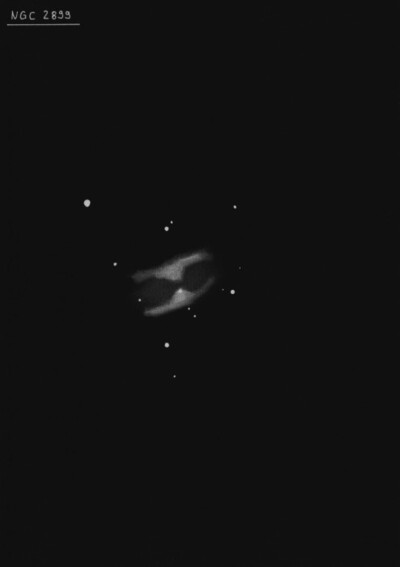
John Herschel discovered NGC 2899 = h3169 on 27 Feb 1835 and recorded "F; pL; R; glbM; 80". At least 80 stars in field." His position is accurate.
300/350mm - 13.1" (2/18/04 - Costa Rica): at 105x this interesting Vela planetary appeared fairly faint, moderately large, slightly elongated ~E-W, 1.3'x1.0'. Good contrast gain with a UHC filter. The surface brightness appears very irregular or mottled with a brighter knot on the SW end that is nearly detached and an irregular darker center. Also a less-defined knot appears to be situated on the north end. Four mag 7.5-9 stars are in the field to the west and north and the PN is situated 9' E of mag 7.3 SAO 236965. The faint planetary Wray 17-31 = VBRC 2 lies 38' ESE
400/500mm - 18" (7/8/02 - Magellan Observatory, Australia): at 171x, this moderately bright planetary is fairly large, ~1.5'x1.0', with an irregular shape and surface brightness. Adding a UHC filter improved the contrast and the PN is clearly elongated with an annular or bi-polar appearance with a darker, irregular center. There are two brighter knots or arcs on on the SW and NE sides of the central section (minor axis?) with the SW knot more obvious. Situated in a fairly rich star field with four mag 7-9 stars including a mag 7.3 star 9' W.
600/800mm - 24" (4/10/08 - Magellan Observatory, Australia): fascinating bipolar planetary at 260x using a UHC filter. A very bright knot is situated on the SW end with fainter extensions along the rim to the SE. A matching knot with a lower surface brightness is on the north side. This knot is also elongated, making another short arc. Overall, NGC 2899 is noticeably elongated with dimensions of ~1.6'x1.0', oriented NW-SE. At 520x both knots or arcs gradually increase in brightness to their centers and occasionally show very faint stellar nuclei. The overall surface is noticeably mottled at this power, though darker in the center. The open cluster IC 2488 lies 50' S.
Notes by Steve Gottlieb